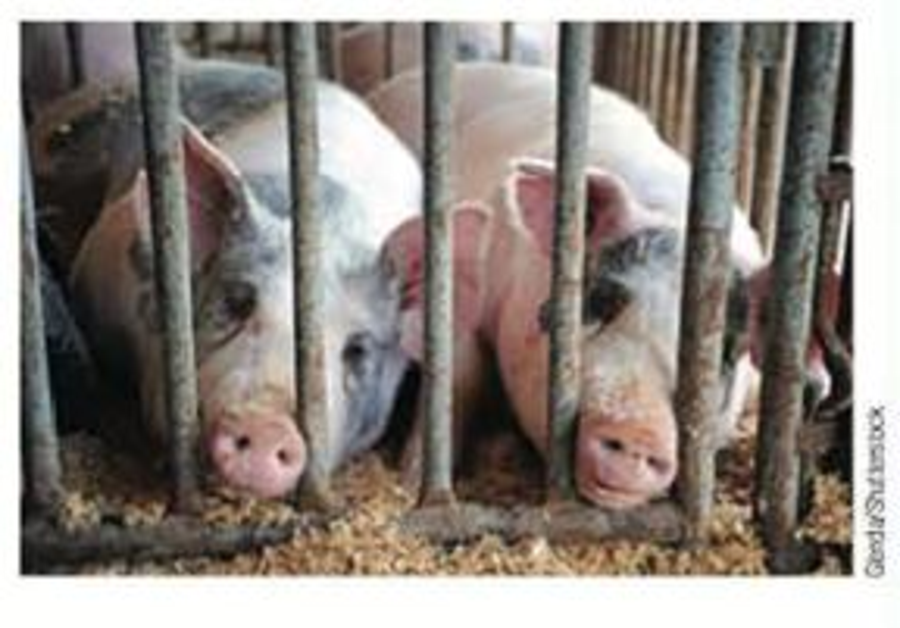
Ethical Dilemma
For the sake of efficiency and lower costs, Premium Standard Farms of Princeton, Missouri, has turned pig production into a standardized product focused process. Slaughterhouses have done this for a hundred years—but after the animal was dead. Doing it while the animal is alive is a relatively recent innovation. Here is how it works.
Impregnated female sows wait for 40 days in metal stalls so small that they cannot turn around. After an ultrasound test, they wait 67 days in a similar stall until they give birth. Two weeks after delivering 10 or 11 piglets, the sows are moved back to breeding rooms for another cycle. After 3 years, the sow is slaughtered. Animal-welfare advocates say such confinement drives pigs crazy. Premium standard replies that its hogs are in fact comfortable, arguing that only 1% die before Premium Standard wants them to and that their system helps reduce the cost of pore products.
Discuss the productivity and ethical Implications of this industry and these two divergent opinions

Summary:
To improve efficiency and incur low costs, PS farms has standardized the pig production into a product-oriented process. They have done this for many years when the animal is dead but not when it is alive.
PS farm says that the hogs are comfortable and only 1% hogs die before they want them to. They also claim that their system is helping in reducing the cost of pork products.
To determine: The productivity and ethical implication of the industry and these two divergent opinions.
Explanation of Solution
Productivity and ethical implication of the industry and these two divergent opinions:
The productivity by the new method has increased the benefits of the industry. The industry also gives lots of job opportunities through its business. Many families and their livelihood are dependent on this business. Hence, from the productivity point of view, this business is essential.
From the ethical point of view, the animals are undergoing tremendous amount of pain in the light. Nobody, can have an idea on the pain they undergo behind closed doors. But, the statistics that only 1% of animals die before they need to supports the claim of PS farm that their practice is not affecting the animals.
Hence, there is fine line between being ethical and unethical when it comes to different practices. Hence, the line must be observed such that one opinion does not fall over the other.
Want to see more full solutions like this?
Chapter 7 Solutions
Principles Of Operations Management
- Prepare a graph of the monthly forecasts and average forecast demand for Chicago Paint Corp., a manufacturer of specialized paint for artists. Compute the demand per day for each month (round your responses to one decimal place). Month B Production Days Demand Forecast Demand per Day January 21 950 February 19 1,150 March 21 1,150 April 20 1,250 May 23 1,200 June 22 1,000' July 20 1,350 August 21 1,250 September 21 1,050 October 21 1,050 November 21 December 225 950 19 850arrow_forwardThe president of Hill Enterprises, Terri Hill, projects the firm's aggregate demand requirements over the next 8 months as follows: 2,300 January 1,500 May February 1,700 June 2,100 March April 1,700 1,700 July August 1,900 1,500 Her operations manager is considering a new plan, which begins in January with 200 units of inventory on hand. Stockout cost of lost sales is $125 per unit. Inventory holding cost is $25 per unit per month. Ignore any idle-time costs. The plan is called plan C. Plan C: Keep a stable workforce by maintaining a constant production rate equal to the average gross requirements excluding initial inventory and allow varying inventory levels. Conduct your analysis for January through August. The average monthly demand requirement = units. (Enter your response as a whole number.) In order to arrive at the costs, first compute the ending inventory and stockout units for each month by filling in the table below (enter your responses as whole numbers). Ending E Period…arrow_forwardMention four early warning indicators that a business may be at risk.arrow_forward
- 1. Define risk management and explain its importance in a small business. 2. Describe three types of risks commonly faced by entrepreneurs. 3. Explain the purpose of a risk register. 4. List and briefly describe four risk response strategies. (5 marks) (6 marks) (4 marks) (8 marks) 5. Explain how social media can pose a risk to small businesses. (5 marks) 6. Identify and describe any four hazard-based risks. (8 marks) 7. Mention four early warning indicators that a business may be at risk. (4 marks)arrow_forwardState whether each of the following statements is TRUE or FALSE. 1. Risk management involves identifying, analysing, and mitigating risks. 2. Hazard risks include interest rate fluctuations. 3. Entrepreneurs should avoid all forms of risks. 4. SWOT analysis is a tool for risk identification. 5. Scenario building helps visualise risk responses. 6. Risk appetite defines how much risk an organisation is willing to accept. 7. Diversification is a risk reduction strategy. 8. A risk management framework must align with business goals. 9. Political risk is only relevant in unstable countries. 10. All risks can be eliminated through insurance.arrow_forward9. A hazard-based risk includes A. Political instability B. Ergonomic issues C. Market demand D. Taxation changesarrow_forward
 Management, Loose-Leaf VersionManagementISBN:9781305969308Author:Richard L. DaftPublisher:South-Western College Pub
Management, Loose-Leaf VersionManagementISBN:9781305969308Author:Richard L. DaftPublisher:South-Western College Pub Practical Management ScienceOperations ManagementISBN:9781337406659Author:WINSTON, Wayne L.Publisher:Cengage,
Practical Management ScienceOperations ManagementISBN:9781337406659Author:WINSTON, Wayne L.Publisher:Cengage,


